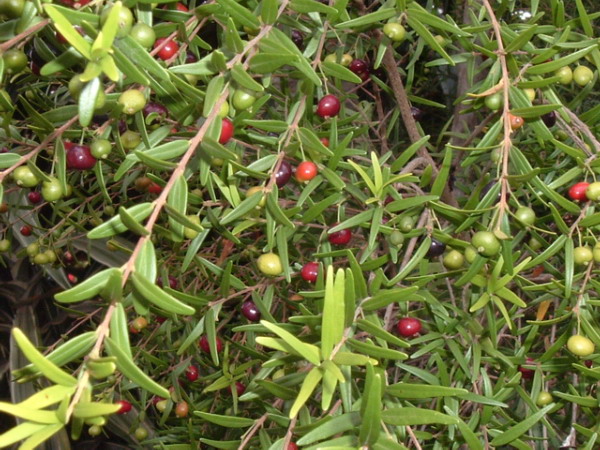- Eugenia
image_caption = "Eugenia sprengelii"
regnum =Plantae
unranked_divisio =Angiosperm s
unranked_classis =Eudicot s
unranked_ordo =Rosid s
ordo =Myrtales
familia =Myrtaceae
genus = "Eugenia"
genus_authority = L.
subdivision_ranks = Species
subdivision = About 1,000; see text|"Eugenia" is a
genus offlowering plant s in the myrtle familyMyrtaceae . It has a worldwide, although highly uneven, distribution in tropical and subtropical regions. The bulk of the approximately 1,000species occur in theNew World tropics, especially in the northernAndes , theCaribbean , and theAtlantic Forest (coastal forests) of easternBrazil . Other centers of diversity includeNew Caledonia andMadagascar . Many species new to science have been and are in the process of being described from these regions. For example, 37 new species of "Eugenia" have been described from MesoAmerica in the past few years. At least 20 new species are currently in the process of being described from New Caledonia, and approximately the same number of species new to science may occur in Madagascar. Ironically, despite the enormous ecological importance of the myrtle family in Australia (e.g. "Eucalpytus", "Corymbia", "Angophora", "Melaleuca", "Callistemon", "Rhodamnia", "Gossia"), only one species of "Eugenia","E.reinwardtiana", occurs on that continent. The genus also is represented inAfrica south of theSahara , but it is relatively species-poor on that continent. In the past somebotanist s included the morphologically similarOld World genus "Syzygium " in "Eugenia", but research by Rudolf Schmid in the early 1970s convinced most botanists that the genera are easily separable. Research by van Wyk and colleagues in South Africa suggests the genus may be comprised of at least two major lineages, recognizable by anatomical and other features.All species are woody
evergreen tree s andshrub s. Several are grown as ornamental plants for their attractive glossy foliage, and a few produce edible fruit that are eaten fresh or used in jams and jellies."Eugenia" species are sometimes used as food plants by the
larva e of hepialidmoth s of the genera "Aenetus " (including "A. splendens") and "Endoclita " (including "E. damor" and "E. malabaricus"). "Aenetus" species burrow horizontally into the trunk then vertically down. OtherLepidoptera larvae which feed on "Eugenia" include "Eupseudosoma aberrans" and Snowy Eupseudosoma.elected species
*"
Eugenia aurata "O.Berg
*"Eugenia aggregata " (Cherry of the Rio Grande )
*"Eugenia alternifolia "
*"Eugenia atropunctata "
*"Eugenia bimarginata " DC.
*"Eugenia blastantha " (O.Berg )D.Legrand
*"Eugenia brasiliensis "
*"Eugenia carissoides "(Cedar Bay Cherry)
*"Eugenia caryophyllata " (an alternate species name for theclove )
*"Eugenia cerasiflora "Miq.
*"Eugenia confusa "
*"Eugenia coronata "
* "Eugenia dysenterica " DC.
*"Eugenia foetida "
*"Eugenia hiemalis "Cambess.
*"Eugenia jambolana "
*"Eugenia klotzschiana "O.Berg
*"Eugenia kunthiana " DC.
*"Eugenia ligustrina "
*"Eugenia livida "O.Berg
*"Eugenia luschnathiana " (Pitomba)
*"Eugenia malaceensis " (Pomarroso)
*"Eugenia monticola "
*"Eugenia natalitia "
*"Eugenia orbiculata "
*"Eugenia pitanga " (O.Berg ex Mart.)Kiaersk. (Pitanga)
*"Eugenia pluriflora " Mart.
*"Eugenia polyantha "
*"Eugenia punicifolia " (Kunth) DC.
*"Eugenia racemulosa "O.Berg
*"Eugenia sprengelii "
*"Eugenia stipitata " (Arazá)
*"Eugenia supra-axillaris "
*"Eugenia uniflora " (Surinam Cherry )
*"Eugenia uruguayensis "Cambess.
*"Eugenia uvalha "
*"Eugenia zeyheri "
*"Eugenia earthiana " found recently in Costa Rica, the name refers to the EARTH superior education institution (Escuela de Agricultura de la Región Tropical Húmeda)."Eugenia aggregata" is native to
Brazil , a large shrub or small tree which grows to 5 meters in height. Leaves are dark glossy green, elliptical, to 7 cm long. White flowers mature into reddish fruits, which grow to 2 cm long and have the flavor of cherries.
Wikimedia Foundation. 2010.

